The Lifecycle of Termites: How Do Termites Breed?
Termites are fascinating yet destructive insects that play a crucial role in ecosystems by breaking down dead wood and other organic matter. Understanding how termites breed is essential not only for pest control but also for comprehending their impact on both natural environments and human structures. In this article, we’ll explore the intricate lifecycle of termites and delve into their breeding habits, providing a comprehensive overview of how these insects reproduce and establish colonies. The Lifecycle of Termites: How Do Termites Breed?
The Termite Lifecycle: An Overview
Termites have a complex lifecycle that includes several stages, each playing a vital role in the survival and growth of the colony. The lifecycle typically begins with the reproductive termites, also known as alates, and progresses through a series of stages that contribute to the expansion of the colony.
The Role of Alates in Termite Colonies
Alates are winged reproductive termites that are responsible for starting new colonies. During specific times of the year, usually after a rain, alates swarm from their nests in search of suitable locations to establish new colonies. This swarming event is often the first sign of a termite infestation in homes or buildings.
Swarming and Mating
The swarming process is a critical stage in the termite lifecycle. Alates from multiple colonies swarm simultaneously, increasing the chances of mating between individuals from different colonies. Once they find a mate, alates shed their wings and become kings and queens, responsible for laying the foundation of a new colony. The mating process is vital to ensure genetic diversity within the colony, which helps the colony adapt and survive.
Colony Formation

After mating, the newly formed king and queen termites begin the process of colony formation. They create a small nesting chamber in the soil or wood and start laying eggs. Initially, the queen lays only a few eggs, but as the colony grows, she can produce thousands of eggs daily. The king’s role is to fertilize the queen’s eggs and help establish the colony. Over time, the colony grows in size, and different castes of termites are produced, each with specific roles.
Understanding Termite Castes and Their Roles
Termite colonies are highly organized social structures composed of different castes, each with specialized functions that contribute to the colony’s survival. These castes include workers, soldiers, and reproductives, with each playing a unique role in the lifecycle and breeding process. https://gekapestmanagement.com.au/termite-treatment-tweed-heads/
The Worker Caste
Workers are the most numerous caste in a termite colony. They are responsible for foraging, feeding the colony, maintaining the nest, and caring for the eggs and young nymphs. Workers are sterile and do not participate in reproduction. Instead, they focus on ensuring the colony’s overall well-being, which indirectly supports the breeding efforts of the queen.
The Soldier Caste
Soldiers, as their name suggests, are responsible for defending the colony from predators, such as ants and other threats. Like workers, soldiers are sterile and do not reproduce. Their primary function is to protect the colony, which is essential for maintaining a safe environment where the queen can continue to breed and the colony can thrive.
The Reproductive Caste
The reproductive caste includes the king, queen, and alates. The queen is the most important member of the colony, as she is the primary egg-layer. As the colony matures, secondary reproductives may develop to assist the queen in laying eggs, especially if the colony becomes large. This caste ensures the continuation and growth of the termite population.
The Breeding Process in Termites
The breeding process in termites is a highly coordinated and continuous cycle that ensures the survival and expansion of the colony. It involves the production of eggs, the development of nymphs, and the emergence of new reproductive termites.
Egg Laying and Incubation
The queen termite is capable of laying thousands of eggs each day, depending on the colony’s size and needs. These eggs are carefully tended to by worker termites, who keep them clean and protect them from harm. The incubation period for termite eggs varies depending on the species and environmental conditions, typically ranging from a few weeks to a couple of months.
Nymph Development
Once the eggs hatch, they develop into nymphs, which are immature termites. Nymphs undergo several molts as they grow, gradually differentiating into one of the colony’s castes: workers, soldiers, or reproductive alates. The development of nymphs is a critical stage in the lifecycle, as it determines the future structure and strength of the colony.
Secondary Reproductives and Colony Expansion
As the colony grows, secondary reproductives may be produced to aid in egg-laying, especially if the primary queen’s egg production declines. These secondary reproductives are typically smaller and less fertile than the primary queen but play a crucial role in maintaining the colony’s growth. The production of secondary reproductives is a survival strategy that ensures the colony can continue to expand even if the primary queen’s reproductive capacity diminishes.
Environmental Factors Influencing Termite Breeding
Termite breeding and colony growth are influenced by various environmental factors. Understanding these factors can help in managing and controlling termite infestations.
Temperature and Humidity
Temperature and humidity are critical factors that influence termite breeding. Termites thrive in warm, moist environments, which are ideal for egg incubation and nymph development. Fluctuations in temperature and humidity can impact the breeding success and overall health of the colony.
Availability of Food Sources
The availability of food sources, such as wood and other cellulose materials, directly impacts the colony’s growth and reproductive success. A plentiful food supply supports a larger workforce, which in turn allows the queen to produce more eggs, leading to rapid colony expansion.
Colony Density and Competition
High colony density and competition with other termite colonies can influence breeding behaviors. In areas with intense competition for resources, colonies may produce more alates to increase the chances of successful mating and new colony formation elsewhere.
Implications for Pest Control
Understanding the breeding habits and lifecycle of termites is essential for effective pest control strategies. By targeting specific stages in the termite lifecycle, such as preventing swarming or disrupting the queen’s egg-laying capabilities, pest control efforts can be more successful in managing and eliminating infestations.
Preventing Swarming
One effective method of termite control is to prevent swarming by sealing cracks and openings in buildings where alates might enter. Additionally, reducing moisture levels around the home can make the environment less attractive to termites.
Disrupting the Breeding Cycle
Pest control treatments that target the queen or secondary reproductives can significantly disrupt the breeding cycle, reducing the colony’s ability to reproduce and grow. This can eventually lead to the decline and elimination of the termite colony.
Regular Inspections and Maintenance
Regular inspections and maintenance of buildings and wooden structures can help identify and address termite infestations early, before they have a chance to establish large colonies. Early intervention is key to preventing significant damage and controlling the spread of termites.
Conclusion
The lifecycle of termites and their breeding habits are complex processes that play a crucial role in the survival and expansion of their colonies. By understanding how termites breed, homeowners and pest control professionals can develop more effective strategies for managing and preventing termite infestations. From swarming and mating to colony formation and expansion, each stage of the termite lifecycle offers insights into how these insects thrive and how they can be controlled. The Lifecycle of Termites: How Do Termites Breed?


